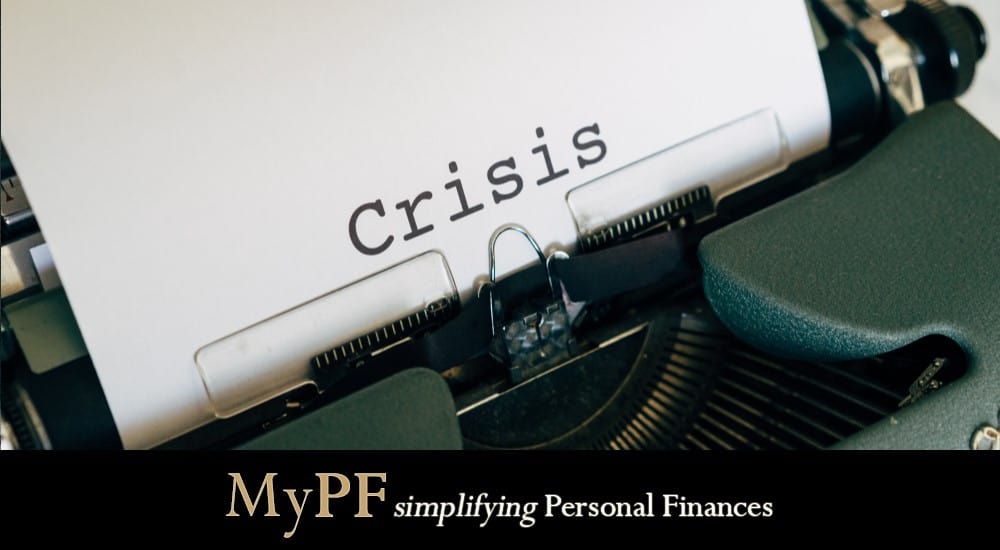Learn to recognise the signs of a financial crisis early to reduce its impact on your financial health.
For decades, the core notion that had controlled personal finance in Malaysia was that markets work. The appropriate price will always find a buyer and a seller, and millions of buyers and sellers are considerably better at identifying the proper price than a few government officials.
However, in the summer of 2007, the markets for various mortgage securities collapsed. Buyers and sellers couldn’t agree on pricing, and the deadlock quickly spread to other debt markets. Banks began to have doubts about one another’s ability to pay their bills. The financial markets did not settle down and begin to function again until late in 2008 when governments stepped in to guarantee that large banks would not fail.
Although residents of a few unfortunate countries like Greece and Spain may disagree, that action appears to have prevented a second Great Depression. However, this recession was unlike any other since the Great Depression, and the global economy is still battling to recover.
Economists have had successful careers. They’ve become powerful presidential advisers, taken over central banks, and held positions of influence at important international financial institutions (the IMF and the World Bank) over the last half-century. Their methods and concepts have permeated other fields, including law and political science, as well as much of the public discourse.
In the aftermath of the financial crisis, the most striking empirical conclusion in corporate governance is that the banks and investment banks that got into the most difficulties in 2008 had the most shareholder-friendly executive compensation and governance arrangements.
Equity made up a small portion of many financial organizations’ balance sheets, implying that shareholders had significantly less to lose than debtors. They were more like thrill-seekers along for the ride, sharing in the profits if a bank’s risk-taking paid off, but only a small fraction of the losses if it didn’t.
Contents
What Constitutes A Financial Crisis?
A financial crisis occurs when the value of financial instruments and assets falls dramatically. As a result, businesses struggle to satisfy their financial obligations, and financial institutions lack the cash or convertible assets necessary to fund projects and meet immediate demands.
Investors lose faith in their assets’ worth, and consumers’ incomes, personal money management, and assets are jeopardized, making it impossible for them to repay their loans.
Many causes can contribute to a financial crisis, perhaps too many to list. Overvalued assets, systemic and regulatory failures, and ensuing consumer panic, such as a significant number of consumers withdrawing funds from a bank after learning of the institution’s financial difficulties, are often the causes of a financial crisis.
Proactive Risk Management Is Crucial
Risk management in the financial world refers to the practice of identifying potential risks ahead of time, analysing them, and taking precautionary steps to mitigate the risk. But how can you do proper analysis and make confident decisions when every single risk assumption changes in a matter of days due to the effects of (for example) a global pandemic?
A solution can be to create cash flow models based on a variety of scenarios, such as a careful examination of demand projections, supply chain disruptions, bad debt, layoffs, and short-term liquidity requirements, but the execution and monitoring of these plans necessitate deep data insights to avoid risks derailing them. Let’s take a look at two forms of risk that are challenging to predict but manageable with the correct tools.
#1. Operational Risk
Operational risk is created by human errors. When the media’s major signals are uncertainty, instability, and anxiety, operational workers are more prone to making mistakes owing to distraction and fear. Stress and trauma are well-known contributors to lower employee performance, higher error rates, and lower work quality. This could result in errors that would otherwise not be commonplace.
At all times, but especially during times of high stress, using a risk monitoring tool that checks for mistakes and abnormalities to discover transactions that don’t follow your business’s usual patterns is a good idea. This external responsibility ensures that errors and abnormalities are identified and corrected before they become an issue. It is vital to have a tool that can validate and double-check human work to reduce operational risk.
#2. Fraud Risk
Insider fraud is the most common type of fraud. What makes fraud so damaging is that it might take up to a year to identify and even longer to unravel and remedy.
The expense of correcting the damage could rise to 2 to 10 times the amount scammed. It can include both tangible costs such as legal fees and tax ramifications, as well as intangible costs like as reputational damage, insurance costs, and other costs associated with penalties or fines.
With this in mind, it’s critical to have a platform in place that analyses every transaction to boost transparency and detect irregularities. These irregularities could be the tip of an iceberg of fraud that was previously unnoticed.
Using Controls For Risk Management
Standardizing the way data is maintained and financial approvals are granted requires procedural controls such as user access security, division of tasks for critical approval processes, and audit trails of users’ data entry and approvals.
Procedural controls, on the other hand, can only function as room doors and locks. It’s the same as installing a camera system if you have a system that monitors and watches everything that happens. Data may be reviewed so that problems or abnormalities can be found and swiftly corrected when everything is constantly monitored.
Artificial intelligence and machine learning are ideal for this type of continuous monitoring because they allow finance executives to spot probable control overrides and use the information to improve operations.
Look Out For Warning Signs Of A Financial Crisis
#1. Reduced Bank Capital
Concerning the enormous, complex financial organizations that fuel the crisis, it may be unwise to loosen capital in the event of a downturn because banks will be unable to sustain the losses. We’ll have 2008 and 2009 all over again if we don’t have a buffer. Despite the measures adopted after the 2008 financial crisis, the financial system would still be in grave danger if one or more large banks failed. Similarly, the world’s most powerful central banks are unprepared to deal with a new banking crisis.
#2. Soaring Private Debt
Credit card debt, subprime auto loans, loans for corporate leveraged buyouts, and general corporate debt are all examples of this type of debt. Any sort of secured lending backed by an inflated asset should be a cause for concern. That is exactly what happened in the housing market.
Keep An Eye On The Economy
Keeping track of major economic indicators over time might help you decipher the signals the economy is delivering. While you may not be able to make certain financial decisions, knowing the economy should help you make more confident decisions about which investments to buy and sell, and when to lock in mortgage rates. The following are some of the most significant statistics to keep track of:
#1. Interest Rates.
At the very least, follow the prime rate, Treasury bill rates, and Treasury bond rates.
The consumer price index (CPI) is the most prevalent indicator of inflation, and it is released in the fourth week of every month for the previous month. The CPI is a measure of the average change in prices paid by urban consumers for a set of goods and services over time. A yearly inflation rate of less than 2% is considered low, between 2% and 4% is moderate, and more than 4% is considered excessive.
Examine the annual rate to see if inflation is rising or falling over time. As the Federal Reserve is committed to keeping inflation under control, this is a carefully watched metric.
#2. Gross Domestic Product (GDP).
GDP is a measure of a country’s output of goods and services, and it includes consumer spending, business investment, government spending, and net exports. Low growth is defined as less than 2%, moderate growth is defined as 2% to 5%, and a boom of more than 5% is considered difficult to sustain.
#3. Unemployment.
Unemployment data are among the most up-to-date statistics, with figures being provided within a week of the month’s end. As a result, unemployment figures are frequently monitored since they can immediately reveal broad-based economic changes.
While low unemployment rates generally reflect a healthy economy, overly low rates might lead to inflationary pressures. Because workers are scarce, businesses must raise wages to attract workers. On the other hand, rising unemployment numbers may indicate that we are approaching a recession.
#4. Corporate Profits.
The performance of businesses is a key measure of the economy’s overall health. Earnings per share for Standard & Poor’s 500 is a typical metric with regard to business profits. If you compare this statistic to the same period last year, you can see whether profits are increasing or falling.
Is There A Financial Crisis Cycle?
The global cycle describes how financial variables generated in the world’s major financial centres – mostly the United States – are transferred to the rest of the globe via capital flows and financial asset prices. There was a common element that accounted for 25% of all risk-bearing financial asset movement. Following that, it was discovered that this component also accounted for around a fifth of all gross capital flows. What is the source of this universal characteristic that characterizes the global financial cycle?
It is risk appetite, a metric that tends to correlate with the VIX, an index that calculates the implied volatility of options on the S&P 50 index’s shares. The lower the VIX, the greater the level of complacency and risk appetite in the markets, which promotes credit expansion and leads to an increase in asset prices.
The global financial cycle, on the other hand, is directly linked to US monetary policy. Changes in this policy affect investors’ expectations and, as a result, the VIX. Through international capital flows, such shifts are conveyed to all other countries (even those with a domestic cycle that differs significantly from that of the US), affecting the leverage of the big banks and the rise of aggregate global credit.
It should also be noted that the global financial cycle has important implications for economic policy: traditionally, macroeconomics supported the view that independent domestic monetary policies could only be achieved with perfectly mobile capital and flexible exchange rates in the presence of perfectly mobile capital (the renowned trilemma, or impossible trinity, of international macroeconomics).
The existence of a global financial cycle, however, has shattered this traditional view: the financial conditions of the major global financial hubs are transmitted to the macro-financial conditions of all other countries, implying that domestic monetary policy (even if the exchange rate is flexible) cannot be fully independent.
In recent years, for example, with industrialized economies experiencing low returns, excess cash has been channeled into neighbouring economies. These other economies have loosened their monetary conditions, imposing interest rates lower than what would be justified by their internal demands, to avoid abrupt currency appreciations and to restrict capital inflows.
As a result, policies that impact capital flows are the only option for accomplishing an independent monetary policy (i.e., shifting from the trilemma to a simple dilemma). These include cyclical macroprudential measures that limit credit and leverage growth during boom periods.
Focus On True Diversification
Diversification is a risk management approach in which a portfolio has a wide range of investments. To restrict exposure to any particular asset or risk, a diversified portfolio incorporates a mix of different asset types and investment vehicles. The theory behind this method is that a portfolio made up of various types of assets will, on average, produce superior long-term returns while lowering the risk of any single holding or investment.
By investing in both foreign and domestic markets, portfolio holdings can be diversified not just across asset classes but also within asset classes. The notion is that one section of a portfolio’s performance will offset the drawbacks in another.
The Importance Of Asset Allocation
Asset allocation is an investment technique that tries to balance risk and reward by allocating assets in a portfolio based on a person’s goals, risk tolerance, and investment horizon. Because the three primary asset classes (equities, fixed-income, and cash and equivalents) have different risk and return characteristics, they will react differently over time.
There is no one-size-fits-all formula for determining the best asset allocation for each individual. Most financial professionals, however, agree that asset allocation is one of the most critical decisions that investors make. In other words, the way assets are allocated in stocks, bonds, and cash and equivalents will be the primary determinants of your investing success, not the specific products you choose.
Conclusion
With the correct preparations and foresight, a person can weather the effects of a financial crisis. Check with your financial planner on steps to enforce your financial portfolio, strengthening it to withstand a crisis when it happens, and how to bounce back effectively and quickly when it is over.
What were your experiences during the last financial crisis? Let us know in the comments down below.














Leave A Comment